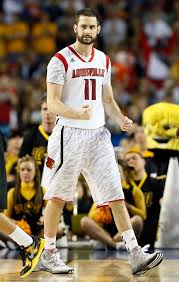 ATLANTA — Luke Hancock etched his place in Louisville — and Kentucky — basketball lore with two late free throws followed by four 3-pointers using his quick-and-smooth set shot stroke — all in a span of 2:34.
ATLANTA — Luke Hancock etched his place in Louisville — and Kentucky — basketball lore with two late free throws followed by four 3-pointers using his quick-and-smooth set shot stroke — all in a span of 2:34.
Was Hancock’s 3-point shooting the main reason the Cardinals were able to make a comeback in the National Championship game?
Simply put: Yes.
Was it the norm for the tournament? Hell no.
Hancock’s 3-pointers brought the ‘Ville back from a 12-point, 33-21 deficit that Michigan had built behind their own sniper-of-the-night, Spike Albrecht, who went on a scoring run of his own, knocking home three straight treys from the 15:00 mark to the 12:06 mark of the first half.
The 3-pointer hadn’t been the Cardinals weapon of choice during their five prior games leading up to the finals. Louisville had been inconsistent from distance, shooting 24-of-76 (31.58%), but they shot 50% in a close title game.
The shooting not only fueled their scoring, but it helped them to set their defense up to pressure the Wolverines in the backcourt so they couldn’t get into their sets as easily, especially with Naismith and Wooden award winning point guard Trey Burke saddled with foul trouble and relegated to the bench in the first half.
Shooting – free throws and 3-pointers – in the NCAA Tournament, though, was not as pretty as it was in this championship game:
The average free throw shooting mark during the regular season was 69.4%, so overall, teams shot better than the average during tournament play.
The average 3-point shooting mark this season was 34%, so teams shot slightly below average from distance, which is partially a product of the pressure-inducing single elimination tournament style of March Madness. When teams get behind, they start jacking up shots (normally bad shots) in attempt to climb back into the game.
Regardless of whether the numbers are better or worse than NCAA’s Division I average, it doesn’t make it OK that teams leave so many points at the free throw line — or that players who aren’t capable 3-point shooters hoist shots up with regularity.
Shooting is a skill that takes time, diligence, hard work and knowledge to acquire. It’s something that goes completely overlooked by many a program, although it probably should be something coaches spend more time teaching their players during the offseason (dranconian NCAA rules permitting, of course).
Just take a look at Andy Enfield, Florida Gulf Coast’s coach and resident shot doctor. Despite their high-flying acrobatics, one of the reasons his team made it to the Sweet 16 was because he helped to mold non-shooters into shooters, morphing their games to a level they didn’t know existed.
It’s difficult to change a player’s shot during the season (a player needs sufficient repetitions to reinforce the right way to shoot), so coaches choose to work on form with players during the offseason. Still, there are so many points to teach and so many bad habits to break that it takes dedication from all involved to become better in this crucial but (somehow) overlooked part of the game.
Sure, teams made just over 7-of-10 shots at the charity stripe … but did you watch the NCAA Tournament? Did you notice how when some players got to the line, the ball had almost no chance of going in because their form hardly resembled what a shot should look like?
Just last night, Tim Hardaway Jr. rocked back-and-forth, back-and-forth at the foul line and missed 2-of-4 attempts thanks to an out-of-rhythm release as a result of wasted motion. As someone who watches with a shooter’s eye, there are so many little kinks in a shot that can make the difference in converting a higher percentage.
If you watched the myriad of close second and third round games, you saw teams miss opportunities to get closer to or to distance themselves from opponents throughout games.
This year, there was no better example than Davidson’s first round matchup with Marquette.
De’Mon Brooks (74.7% FT shooter) – Davidson’s best player – had possession as his team attempted to break through Marquette’s pressure in the backcourt. He could’ve held the ball and been fouled, which would’ve put him at the charity stripe with an attempt to ice the game…
But he threw a skip-pass downcourt that sailed out of bounds.
Why?
Because he was 5-of-11 at the line in that game – his shots continuously falling short – and he lacked the confidence to get fouled with the game on the line.
Vander Blue took full advantage of the opportunity, scoring a nifty, buzzer-beating layup, which propelled the Golden Eagles into the next round.
When will coaching staffs and players give shooting its proper due?
When will they realize that getting getting shots up the wrong way during practice time is going to lead to misses and frustration during games – especially close ones?
Whether they want to admit it or not, there isn’t enough of an emphasis on teaching the proper fundamentals of a jump shot, and everyone – coaches, players and fans – suffers as a result.
Basketball needs a lot more Andy Enfields out there; coaches who help individuals to improve players shooting strokes to the point where they believe the sky is the limit.
Because when players shoot with confidence in the proper fundamentals, it can transform their game and open up the playbook for coaches.
Jeremy Bauman is an aspiring shooting coach and scout who writes columns and blogs for SheridanHoops.com. Follow him on Twitter.
